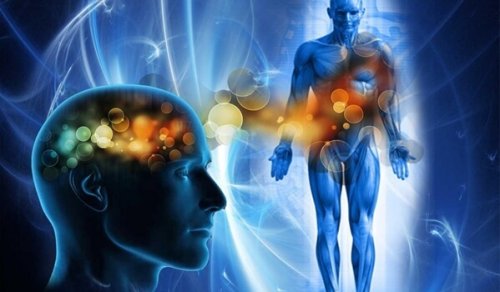Psychosomatic Disorders: when your Mind Hurts your Body


Written and verified by the psychologist Valeria Sabater
Psychosomatic disorders are proof of the power that the mind can have over the body. In a psychosomatic episode, the patient experiences a series of real physical symptoms that relate to an invisible disease. The condition doesn’t exist organically. Rather, it is the result of mental conflicts or unresolved problems that eat at the patient from the inside.
It is hard to believe a story about students who lose their vision before a test because of anxiety. Likewise, the story of a 60-year-old woman who loses mobility in her legs because she believes she has a tumor in her spine seems exaggerated and difficult to understand.
“Your body is telling you that something isn’t right inside, and you aren’t seeing it.”
-Suzanne O’Sullivan-
Is it real?
As hard as it is to believe, there is plenty of evidence that these kinds of things happen every day. They happen all the time, and all over the world. As a result, neurologists and specialized psychologists have quickly learned to give psychosomatic disorder patients the space to talk about what is happening to them. If they say they have pain, it’s probably real even if it doesn’t show up in an MRI scan or a blood test.
It is essential to validate these patient’s suffering. The same is true for patients with depression who say they have suicidal thoughts or a person with schizophrenia who has visions and hallucinations. These realities exist in their minds and they can be devastating. When our minds, traumatized and subject to intense anxiety, take control, anything is possible.

Psychosomatic disorders – is it really all in my head?
Psychosomatic disorders include all sets of symptoms that don’t have a physical or organic correlation. They are the pains and limitations that are purely the result of mental processes. Now, we know what that might lead you to assume – is it really all in my head?
The truth is, the field of study of psychosomatic disorders is still full of mysteries. Something we do know is that this spectrum of physical disorders associated with mental stress has a cerebral correlation: the hyperactivity of nervous impulses in the brain when they communicate with different areas of our bodies.
Who suffers?
- Something else that patients exhibit is an excess of adrenaline in the blood, as well as some altered biological parameters. One example of that is an accelerated metabolism of glucose or amino acids.
- At the same time, scientists have demonstrated that some people are more susceptible to psychosomatic disorders. Patients who live with a lot of anxiety or had a traumatic childhood due to abuse or neglect tend to be more likely to experience this type of disorder.

There is something more important than understanding or not understanding what causes psychosomatic illnesses. Imagine a doctor that explains to his patient that what she imagines isn’t real. That the chest pain isn’t a heart attack, that she didn’t lose her voice because of a problem with her vocal chords, or that her terrible migraine is not caused by a tumor. It’s fine to tell a patient what she doesn’t have, but how do we help her heal what she does have if it’s all in her mind?
“This is something that happens to all of us. But I couldn’t say why this mechanism decides to create a pathology in certain individuals. The thing is that we all have a different way of dealing with stress.”
-Suzanne O’Sullivan-
Problems generated by the mind
Psychosomatic disorders can affect any organ, system, tissue, or structure. Their impact can be intense, we shouldn’t underestimate the power of our psyche. Likewise, it’s important to differentiate between a somatic symptom disorder and a psychosomatic disorder. In the former, there are never any physical symptoms. In the latter, there is visible damage in the body (ulcers, for example.) Here are examples of some of the illnesses:
- The most classic examplse of psychosomatic disorders are dermopathies like eczema, hives, infections, acne, etc…
- Hypertension, tachycardia, difficulty breathing, and shooting chest pains are other common symptoms.
- Disorders of the digestive system are very common. The most frequent are Irritable Bowel Syndrome and ulcers.
- Intense headaches and migraines are also very common.
- Memory loss.
- Bronchial asthma.
- Menstrual pain, menstrual disorders…
- Alopecia
- In extreme cases, some patients experience temporary blindness, paralysis of a limb, fainting spells, etc.

What is the treatment for psychosomatic illnesses?
There are two approaches to the treatment of psychosomatic illnesses. On one hand, the first and obvious approach is to treat the physical symptom that the patient presents (ulcers, infection, eczema…). The most important thing in these cases is to figure out what the root of the problem is. In other words, to understand the psychological roots of the issue. That unresolved mental tension manifests itself in the body to varying degrees.
The treatment approaches for these cases vary. They always depend on the particular details of each case. Likewise, sometimes the best course of action is to try different therapies to see which one works best for the patient. The therapist can try and observe which techniques have the most positive results.
- Relaxation techniques are always very effective.
- Cognitive behavioral therapy is enormously helpful to teach patients new ways to manage their problems. They will understand the way their mind works, apply realistic life goals, and identify the thought patterns they need to change. That will help them have a more positive lifestyle.
- Another type of therapy that has similarly positive results is psychoanalysis. This is effective to treat mental and emotional conflict, as well as anxiety disorders.
- Group therapy such as psychodrama (created by Jacob Levy Moreno) is another useful, stimulating, and gratifying strategy. Therapists can try this one to see if it has positive results for their patients.
In conclusion, finding a solution for patients suffering from psychosomatic illnesses is an important challenge for doctors today. The reality for these patients is sometimes very difficult, and it deserves our attention and sensitivity.
Psychosomatic disorders are proof of the power that the mind can have over the body. In a psychosomatic episode, the patient experiences a series of real physical symptoms that relate to an invisible disease. The condition doesn’t exist organically. Rather, it is the result of mental conflicts or unresolved problems that eat at the patient from the inside.
It is hard to believe a story about students who lose their vision before a test because of anxiety. Likewise, the story of a 60-year-old woman who loses mobility in her legs because she believes she has a tumor in her spine seems exaggerated and difficult to understand.
“Your body is telling you that something isn’t right inside, and you aren’t seeing it.”
-Suzanne O’Sullivan-
Is it real?
As hard as it is to believe, there is plenty of evidence that these kinds of things happen every day. They happen all the time, and all over the world. As a result, neurologists and specialized psychologists have quickly learned to give psychosomatic disorder patients the space to talk about what is happening to them. If they say they have pain, it’s probably real even if it doesn’t show up in an MRI scan or a blood test.
It is essential to validate these patient’s suffering. The same is true for patients with depression who say they have suicidal thoughts or a person with schizophrenia who has visions and hallucinations. These realities exist in their minds and they can be devastating. When our minds, traumatized and subject to intense anxiety, take control, anything is possible.

Psychosomatic disorders – is it really all in my head?
Psychosomatic disorders include all sets of symptoms that don’t have a physical or organic correlation. They are the pains and limitations that are purely the result of mental processes. Now, we know what that might lead you to assume – is it really all in my head?
The truth is, the field of study of psychosomatic disorders is still full of mysteries. Something we do know is that this spectrum of physical disorders associated with mental stress has a cerebral correlation: the hyperactivity of nervous impulses in the brain when they communicate with different areas of our bodies.
Who suffers?
- Something else that patients exhibit is an excess of adrenaline in the blood, as well as some altered biological parameters. One example of that is an accelerated metabolism of glucose or amino acids.
- At the same time, scientists have demonstrated that some people are more susceptible to psychosomatic disorders. Patients who live with a lot of anxiety or had a traumatic childhood due to abuse or neglect tend to be more likely to experience this type of disorder.

There is something more important than understanding or not understanding what causes psychosomatic illnesses. Imagine a doctor that explains to his patient that what she imagines isn’t real. That the chest pain isn’t a heart attack, that she didn’t lose her voice because of a problem with her vocal chords, or that her terrible migraine is not caused by a tumor. It’s fine to tell a patient what she doesn’t have, but how do we help her heal what she does have if it’s all in her mind?
“This is something that happens to all of us. But I couldn’t say why this mechanism decides to create a pathology in certain individuals. The thing is that we all have a different way of dealing with stress.”
-Suzanne O’Sullivan-
Problems generated by the mind
Psychosomatic disorders can affect any organ, system, tissue, or structure. Their impact can be intense, we shouldn’t underestimate the power of our psyche. Likewise, it’s important to differentiate between a somatic symptom disorder and a psychosomatic disorder. In the former, there are never any physical symptoms. In the latter, there is visible damage in the body (ulcers, for example.) Here are examples of some of the illnesses:
- The most classic examplse of psychosomatic disorders are dermopathies like eczema, hives, infections, acne, etc…
- Hypertension, tachycardia, difficulty breathing, and shooting chest pains are other common symptoms.
- Disorders of the digestive system are very common. The most frequent are Irritable Bowel Syndrome and ulcers.
- Intense headaches and migraines are also very common.
- Memory loss.
- Bronchial asthma.
- Menstrual pain, menstrual disorders…
- Alopecia
- In extreme cases, some patients experience temporary blindness, paralysis of a limb, fainting spells, etc.

What is the treatment for psychosomatic illnesses?
There are two approaches to the treatment of psychosomatic illnesses. On one hand, the first and obvious approach is to treat the physical symptom that the patient presents (ulcers, infection, eczema…). The most important thing in these cases is to figure out what the root of the problem is. In other words, to understand the psychological roots of the issue. That unresolved mental tension manifests itself in the body to varying degrees.
The treatment approaches for these cases vary. They always depend on the particular details of each case. Likewise, sometimes the best course of action is to try different therapies to see which one works best for the patient. The therapist can try and observe which techniques have the most positive results.
- Relaxation techniques are always very effective.
- Cognitive behavioral therapy is enormously helpful to teach patients new ways to manage their problems. They will understand the way their mind works, apply realistic life goals, and identify the thought patterns they need to change. That will help them have a more positive lifestyle.
- Another type of therapy that has similarly positive results is psychoanalysis. This is effective to treat mental and emotional conflict, as well as anxiety disorders.
- Group therapy such as psychodrama (created by Jacob Levy Moreno) is another useful, stimulating, and gratifying strategy. Therapists can try this one to see if it has positive results for their patients.
In conclusion, finding a solution for patients suffering from psychosomatic illnesses is an important challenge for doctors today. The reality for these patients is sometimes very difficult, and it deserves our attention and sensitivity.
All cited sources were thoroughly reviewed by our team to ensure their quality, reliability, currency, and validity. The bibliography of this article was considered reliable and of academic or scientific accuracy.
- O’Sullivan, S. (2016) Todo está en tu cabeza. Barcelona: Ariel
- Ramírez, M. T. G., & Hernández, R. L. (2008). Síntomas psicosomáticos y estrés: comparación de un modelo estructural entre hombres y mujeres. Ciencia-Uanl, 11(4), 11.
- Velasco, C. B., Vilarrasa, A. B., Fénétrier, C., & Nargeot, M. C. G. (2011). Trastornos psicosomáticos y su rela-ción con alexitimia, ansiedad, depresión y demanda de ayuda psicológica. Psicología y salud, 21(2), 227-237.
This text is provided for informational purposes only and does not replace consultation with a professional. If in doubt, consult your specialist.







